Homemade Butter Fingers
Butterfinger candy bars are—along with their cousins Clark, 5th Avenue, and Zagnut—candy delights that we, as adults, often only get when we raid our kid’s Halloween hauls. Wouldn’t it be great if you could make these treats at home any time of the year? Wouldn’t that make your dentist happy? Yes it would!
As with any candy making, temperature control and monitoring is of utmost importance. If you over cook sugars by even a few degrees, you can change their texture entirely. So get out your Thermapen® and let’s make some crispity goodies!
The Butter Fingers’ Crunchy Layers
What makes butter fingers special is the crispy, sticky-in-the-teeth layered candy filling. The tender bite in combination with the loud crunch is characteristic of this kind of bar. But how do we get that?
Obviously a solid-poured candy won’t do, as those are too hard for happy munching. What we need is a laminated candy. This method is based on the French mille-feuille craquant (a thousand leaves of crunch), and much like laminating a dough for croissants or puff pastry, this laminated candy is made by repeatedly folding and rolling out the candy mass. In this way, we develop many very thin layers very quickly. We will fold this candy in thirds at least 3 times, resulting in 27 layers of candy, plus multiple layers of filling.
The filling layers will be composed of a peanut mixture and corn flakes in place of the butter used for laminated doughs. The thin, brittle layers of the resulting candy are tender to the bite without hurting your teeth, and the cornflakes help to amplify the crunch.
Syrup Temperature
To make a laminated candy, we first need to start with a sugar syrup. In this case, we use sugar, water, corn syrup (for ease of use), molasses (for depth), and vanilla bean (for fanciness). We boil this mixture to a temperature of 280°–290°F(138°–143°C), also known as “soft crack” stage, which has a sugar content of about 95% (See On Food and Cooking by Harold McGee, pg. 681). The “soft crack” stage is sugary enough to harden to a crunch, but soft enough to roll out and work with.
As with all candy making, accuracy is very important in this step, as a few degrees over or under the target temperature range can result in either a syrup that won’t set to a crunch or, conversely, that will crack and break rather than fold and bend. We recommend a Thermapen for use as a highly responsive and highly accurate candy thermometer. You’ll love the control high accuracy gives you when working with sugar.
Re-warming to Maintain Pliability
Even with proper syrup cooking, we have to be careful of cracking the butter finger candy while we work it. If the surfaces of the candy cool too much, they will become brittle and break under the rolling pin. To prevent the candy from this, we keep our oven at 200°F(93°C) and put the candy in the oven to soften between folding and rolling steps. This keeps the mass pliable and workable. We needn’t fear that the candy is cooking too much, as the 200°F(93°C) oven we warm it in is far below the 300°F(149°C) needed to advance it to the hard-crack stage.
A Chocolate Coating that Lasts
If you’ve ever melted chocolate for dipping, you know that when it re-solidifies, it does not have the same physical properties as before melting. The reason for this is that it has lost its temper—and we all know that angry chocolate is a mess (*wink*).
Tempered chocolate has a specific crystal structure that allows it to stay solid at higher temperatures than non-tempered chocolate. All the chocolate you buy at the store has been tempered, which is why you can eat a chocolate bar before it melts all over your hands. Tempered chocolate also has a glossy sheen and snaps when you break it. It also has a better mouth-feel.
To make our homemade butter fingers more user-friendly, we will temper out chocolate using the seed method. We’ll melt ⅔ of of our chocolate to to 115°F(46°C) as measured on our Thermapen before adding the rest of the chocolate to the mixture. Then we’ll stir the chocolate to an even consistency and cool it down to 81°F(27°C). Finally, we’ll bring it all back up to 90°F(32°C) before we dip our butter fingers for their chocolate coating. (If you would like to learn more about tempering chocolate, check out our awesome Chocolate Tempering Made Easy post.)
Now, armed with weapons of knowledge, let us proceed to the kitchen, and conquer.
Homemade Butter Finger Bars
Based on Stella Parks’ recipe at Serious Eats:
Ingredients
- 4 ounces water
- 1 1/4 ounces molasses
- 1 ounce corn syrup
- 8 ounces sugar
- 1 vanilla bean, split and scraped
- 8 ounces roasted, salted peanuts
- 2 ounces powdered sugar
- 1/2 ounce corn flakes
- 40 ounces couverture chocolate, divided
Instructions
Candy
- First, preheat your oven to 200°F(93°C) and place in it a jelly roll pan lined with a silicone mat.
- In a medium pot, combine water, molasses, corn syrup, sugar, and vanilla bean seeds.
- Set over medium heat and stir gently with a fork, taking care not to splash, until sugar dissolves and the mixture begins to simmer.
- Simmer, undisturbed, until the mixture reaches 280°–290°F(138°–143°C)—soft crack stage—as measured on an instant-read thermometer like the Thermapen. (Adjust your temperature based on your elevation by subtracting 2°F(1.1°C) per 1,000 ft elevation.)
- While the syrup is cooking, grind the peanuts and powdered sugar together in a food processor until the mixture forms a thick, damp mass with a texture like wet sand. Set aside.
- When the syrup comes to temperature, immediately pour the mixture onto the silicon mat in the sheet pan, taking care to keep the syrup within the center of the mat.
- Spread the syrup with a heat proof spatula or by tilting the pan left and right to help the syrup evenly coat the silicon mat into a roughly 14” x 10” rectangular shape. This will look like a tiny amount of candy but don’t worry, it will get bigger.
- Sprinkle the peanut mixture over ⅔ of the surface of the candy, then use the silicone mat to fold the remaining ⅓ of the candy over, like folding a letter. If the candy sticks to the mat, wait a few moments while it cools slightly.
- Using the mat again, fold the double-thick section over the final third. You will now have a 3-layer candy packet roughly 11” x 5”.
- Place the sheet pan in the oven and let the candy warm to become pliable, about 5 minutes.
- Remove the sheet pan from the oven, take the candy out of the pan, and roll it out with a rolling pin, trying to achieve a 10” x 14” rectangle again. This will be difficult work. If at any time it becomes too stiff and hard to work or you start to hear the sugar cracking, just throw it back in the oven on the pan for another minute or two and try again.
- Once you’ve rolled it out, fold it in thirds again and return it to the oven for another 5 minutes.
- Once softened, roll this packet out one more time. This time, sprinkle the corn flakes over ⅔ of the surface, just like we did with the peanut mixture before, and fold it in as at the first.
- Return the pan to the oven, heat, and then roll it out again, this time to a ½” thickness. You will hear cracking as you use the rolling pin, but that’s just the cornflakes.
- With a knife, trim the edges of this mass so you have a neat rectangle. Cut this mass into whatever shape and size you want your candy bars to be.
Chocolate
- Temper your chocolate by first melting 26 ounces of it to 115°F(46°C) over a double boiler.
- Once you achieve the right temperature, mix in the remaining 14 ounces, mixing it in while it melts.
- Remove the chocolate from the heat to allow the mixture to cool to precisely 82°F(28°C).
- Then return the chocolate to the heat and raise the temperature of the chocolate to 89°F(32°C). It is now ready for dipping.
- Separate 12 ounces of the tempered chocolate to use as a “crumb coat.”
- Drizzle or pipe a thin line of chocolate onto the bottom of each candy piece and then flip each over to form a foot on the bottom.
- Next, use a small pastry brush to evenly coat the bar in a thin layer of chocolate.
- Once the crumb coat has set, dip the bars into the chocolate with dipping forks and set aside to firm firm and dry. You will probably have a good deal of extra melted chocolate. Pour it out on a parchment-lined tray and let it cool. You can break it up and put it in a zipper-bag in the cupboard until you need chocolate again.
- Pat yourself on the back! With your knowledge of candy syrup temperatures and a quality thermometer like the Thermapen, you’ve created delicious, flaky, crispy peanut-buttery candy bars!
Candy making can seem daunting, but even flaky, professional-seeming candy bars can be made in your own home with careful temperature monitoring and a little patience. So give these homemade butter fingers a try and impress yourself with what you can do! Your friends and family will shower you with praise.
Products Used:
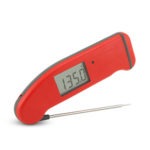 |
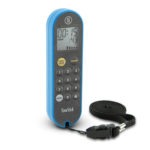 |
|---|


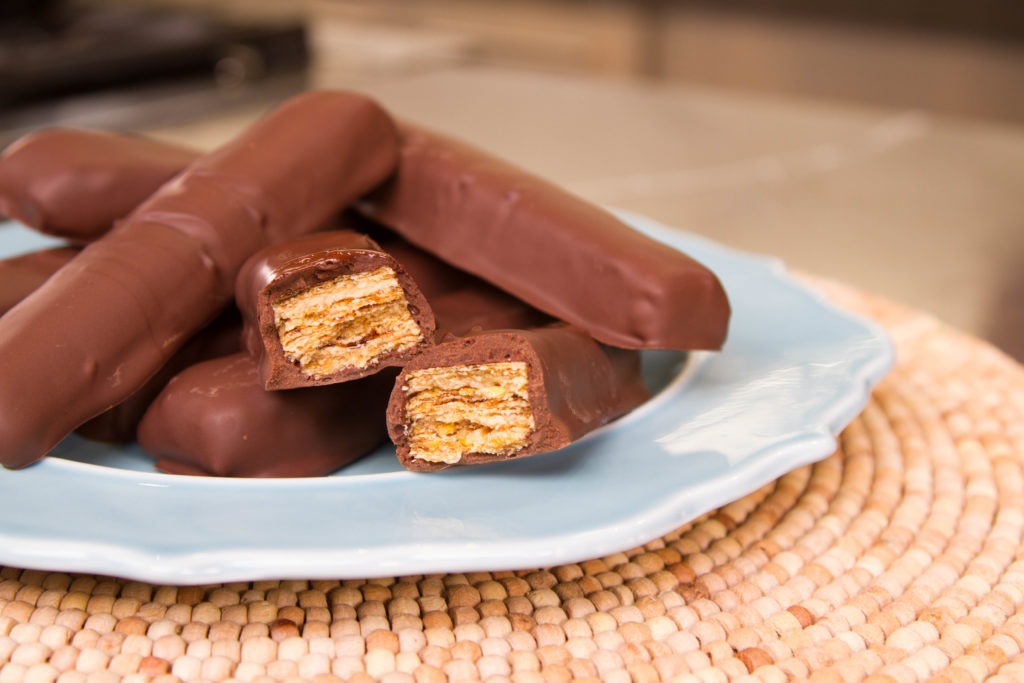
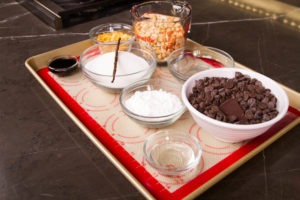









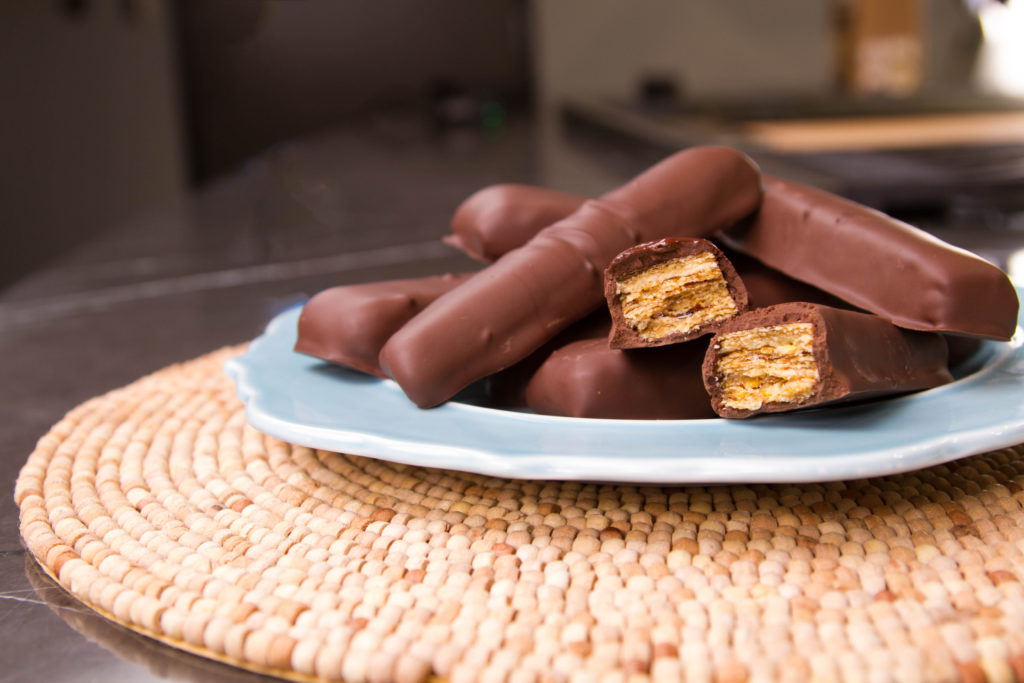
Amazing.
Love this!
Lets see a recipe shared for Soft Peanut-Butter Brittle. Our local Rosauer’s grocery store (in Oregon) makes it and it is a great treat – and not so hard as to hurt your teeth.
That sounds tasty! Anyone out there have a recipe? Comment it here!
I did an Internet search and compared the recipes. The difference I found between hard brittle and soft brittle is that warm peanut butter is folded into the hard brittle before it poured out onto the marble or baking sheet to cool. The addition of the fats and proteins from the peanut butter would lubricate the sugar molecules as they cool and crystalize thus forming a weaker matrix. With a bonus of adding additional peanut-esque flavor.
One recipe that looked like a winner:
https://kristagilbert.com/davenport-soft-peanut-brittle-recipe/
Can this be made with sunflower seeds instead of peanuts or with store-bought seed butter of any type (almond butter, cashew butter or soy butter)?
I think, you could use any nutty-seed for it. Pumpkin sees, for instance, might be very fun. Cashews would be phenomenal.
Is there a way to use store-bought nut butter for this recipe instead of having to grind up some seeds?
You could try it, but I’m not sure how it would work. The powdered sugar would help dry and powder-up the nut butter, so it could go. But for textural reasons, I think grinding the nuts to a barely-releasing-oils stage is going to be better. Absolutely worth a try!